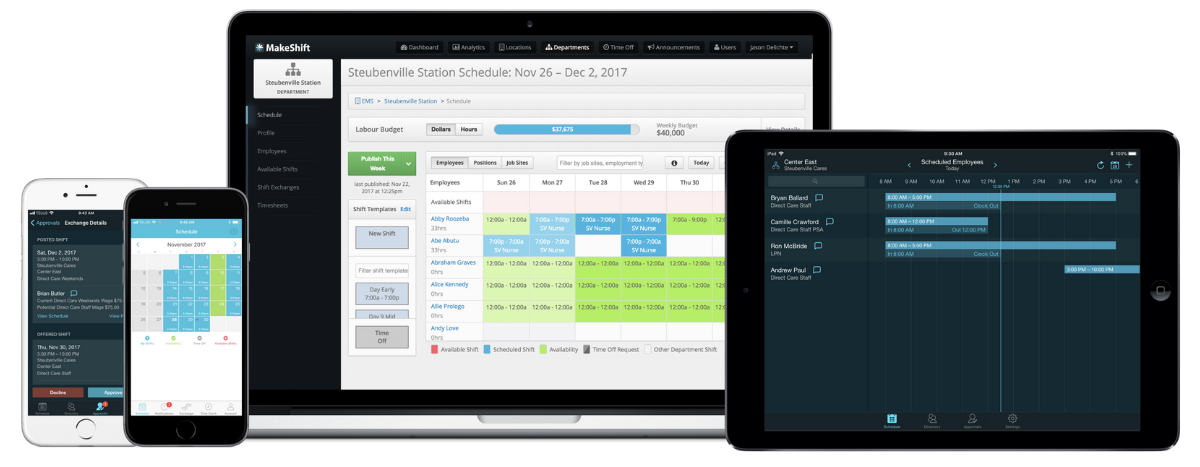Employee experience plays a crucial role in influencing your staff’s level of ownership in their work, including filling open shifts.
When you adopt a people-first approach, you get happier employees who own their responsibilities on a whole new level.
They contact coworkers to cover an open shift if they can’t make it to work. They DON’T dump their shift woes on you.
To upgrade your employee experience, focus on areas like:
- Communication
- Professional growth & development
- Recognition & kudos
- Collaboration
- Work-life balance & well-being
- Your physical work environment
- Tech to support these areas
This article addresses the issue of chronic open shifts at the root cause with employee experience. We also recommend the tools you need to empower your staff to fill open shifts for you.
Feel free to skip to the part you’re most interested in:
- How to Fill Open Shifts By Upping Employee Experience
- How to Empower Your Staff To Fill Open Shifts with Software
- FAQ About Open Shifts
- Encourage Your Staff to Fill Open Shifts Through a Better Work Culture
How to Fill Open Shifts By Upping Employee Experience
Employee experience plays a significant role in shaping the level of ownership employees take in their work roles. And that includes filling open shifts.
A people-centric company culture helps your staff get excited about work and make it a place they want to be.
This makes employees feel valued and supported, so they’re more likely to:
- Readily volunteer
- Anticipate and solve problems
- Go above and beyond with their work
- Not commit time theft
- Not leave their shift uncovered
Here are 7 ways the world's top companies are curating a company culture of ownership that employees are happy to be a part of.
1. Encourage communication
The best internal communication strategies go beyond managing and distributing information. They foster an engaging environment ripe with relationships built on trust.
Communication isn’t just to inform — it’s key to culture.
Ask for and actually use employee feedback, ideas, and suggestions.
The primary goal is to create a cohesive work environment where employees are unified in your company’s mission.
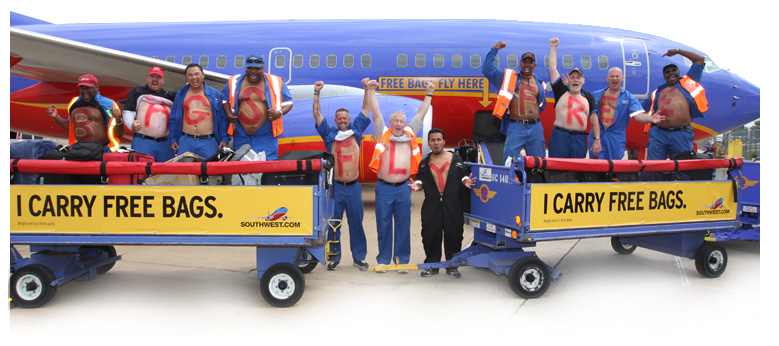
Southwest Airlines is regularly recognized for its strong company culture and excellent communication practices. They have a program called “Communicate to Motivate” that encourages employees to share feedback and ideas.
They also have a daily huddle where employees can share updates and communicate about any issues.
Southwest prioritizes communication to create community — they’re clear about their message and consistent in how they roll it out.
- Southwest has a well-defined content strategy — they can keep content purposeful and make sure it always "sounds like Southwest.”
- Southwest asks employees to share content on their blog. Since implementing this, readership is through the roof. People LOVE hearing stories from their peers.
- Southwest uses multiple communication channels to share, explore, and inform. They even have an internal Facebook group dedicated to their people and culture.
2. Offer professional growth and development
What happens if you train your employees and they leave? Well, what if you don't and they stay? 71% of Fortune 500 companies have workplace mentoring programs, while many more support informal initiatives.
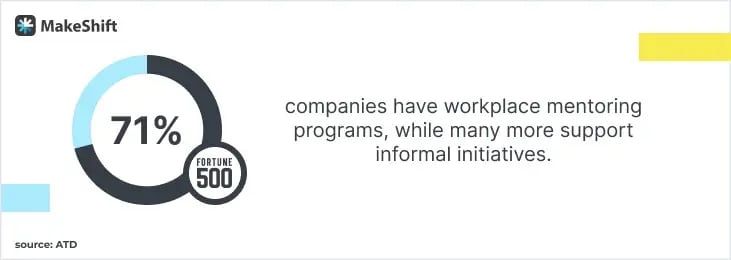
Growth and development programs aren’t only about providing your employees with tools to do their job well, it’s also about helping your team feel challenged, motivated, and ready to tackle new endeavors.
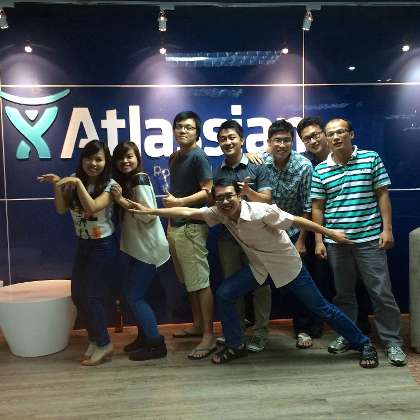
Atlassian develops products and practices that help teams around the world collaborate, so it’s no surprise they’ve poured that energy into their own employee experience.
At Atlassian, they believe that access to education, training, and resources is critical to achieving goals and moving forward. People have different needs and learning approaches, so their goal is to support everyone’s growth and development through a mix of offerings.
To promote this, they offer Atlassians (employees of Atlassian):
- An annual learning budget
- Internal training portal with a mix of self-paced and instructor-led learning courses
- A library of thousands of online development courses through LinkedIn Learning and Degrees
- A business book portal to help cultivate new interests
3. Recognize and give kudos for employee contributions and achievements
Want your employees to fill open schedule shifts? Make them feel seen and valued for their contribution to your company.
Let ‘em Know you Know.
An employee recognition program tells your staff you know they drive the company’s success.
You’ve got employees with a plethora of personalities and interests. Your recognition program has to be just as diverse and requires the “different strokes for different folks” approach.
Employee kudos can come in many forms:
- Service awards
- Monetary awards
- Public shout out
- Special celebrations
- Office parties
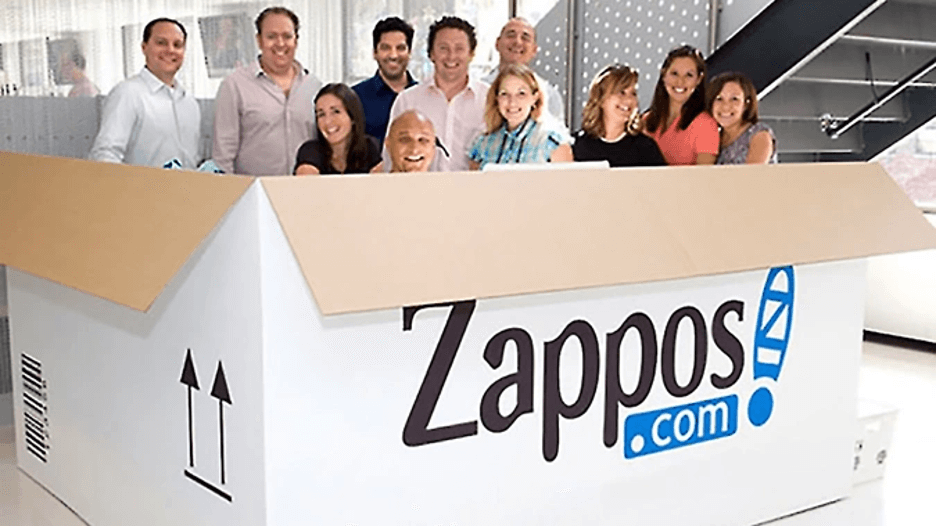
Zappos, a subsidiary of Amazon, has an employee recognition program that is based on peer-to-peer employee recognition. The peer-to-peer employee rewards in Zappos aim to build a culture of appreciation among colleagues and an overall positive team spirit.
Employees are called “Zapponians,” — some of the peer-to-peer programs include:
- Zollar Program — Zollars (Zappos Dollars) is play money Zapponians can share with peers. Zollars are earned when a team member volunteers to help out. They can use Zollars to redeem merch from the Zollar Store.
- Master of WOW Parking — Colleagues can reward other employees with a premium parking space.
- Coworker Bonus Program — Zapponians can reward one another with a $50 coworker bonus. They can give each other a max of 1 bonus per month, but they can receive more than 1 as long as they’re given by different people.
4. Foster a culture of teamwork, collaboration, and mutual respect
It’s no surprise that the majority of successful startups that go on to greatness are built by teams.
This is because a team has the potential to complete tasks in less time, with higher quality, and at a lower cost than an individual working alone.
You can reduce employee turnover rates by 50% by promoting communication and collaboration, according to a Zippia report. And in a Khris Digital survey, 47% of employees said they’d stay with a company that lets them “work with a great team.”
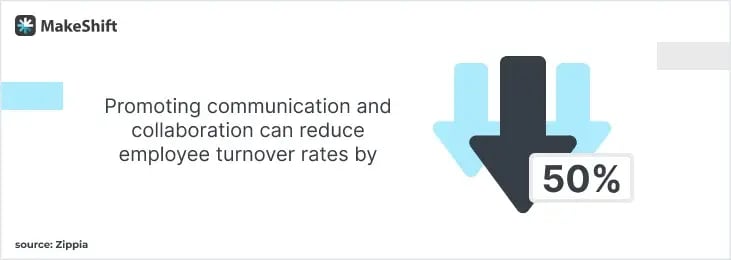
However, there’s more to successful collaboration than saying, “Hey guys, be more collaborative.” Take note of how Google does it.
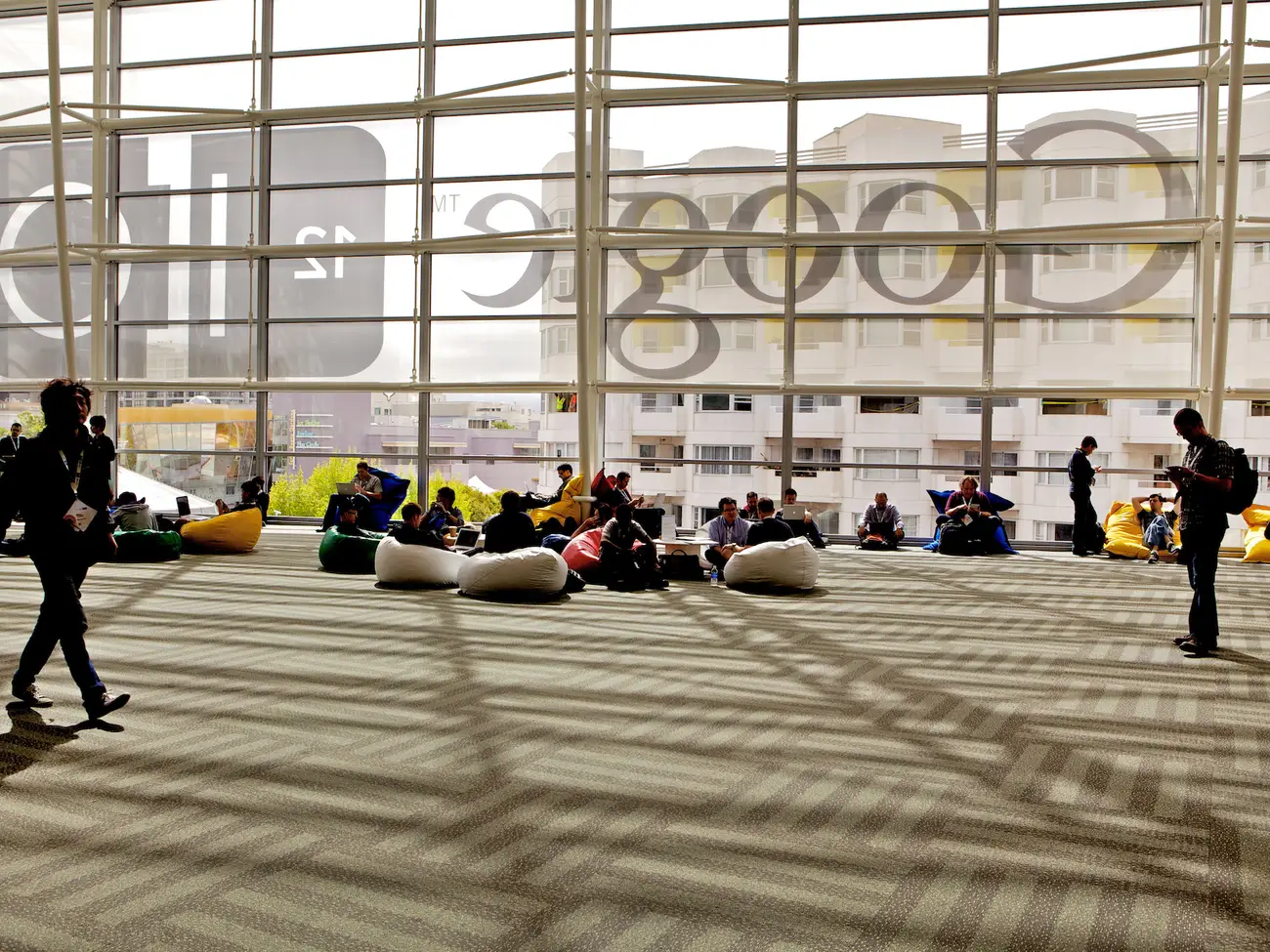
Google culture is arguably the most innovative in the world. Their approach to collaboration has been uber successful — they know it’s important for creativity and keeping up with market trends.
Prioritizing collaboration at Google led them to launch the Aristotle Project in 2012 to dig into what makes some groups successful, and others stumble.
Hundreds of hours and millions of benjamins later, they found that culture is king when it comes to high-level collaboration.
The culture of Physiological Safety.
Harvard Business School professor Amy Edmondson defines psychological safety as the feeling of security in a group setting where everyone feels the “comfort to contribute.”
Follow Google’s unwritten rules of collaboration:
Let the people speak! Here’s what that looks like:
- Everyone gets roughly equal air time in group communication.
- Active listening must be learned and supported — Practice empathy and NEVER embarrass or reject someone who expresses an idea or their feelings.
- Intrusive interruption and theft of ideas aren’t tolerated.
5. Support & encourage healthy work-life balance and employee well-being initiatives
Employee well-being initiatives are beneficial for both your employees and your organization.
These initiatives prioritize employees' physical, mental, and emotional health, recognizing that their well-being is essential for productivity and satisfaction.
By offering resources and support for well-being, you create a positive work environment where team members feel valued and cared for. This leads to increased engagement, motivation, and ownership.
-Aug-04-2023-07-45-45-3843-PM.png?width=1600&height=718&name=unnamed%20(1)-Aug-04-2023-07-45-45-3843-PM.png)
Asana takes employee well-being to heart.
Let’s start with naps. That’s right, you can get paid to sleep at Asana in one of their “nap rooms” — employees can rest up, recharge, and de-stress.
The company also offers unlimited PTO to help employees achieve work-life balance, as well as daily yoga programs and free gym memberships.
Oh, and let’s not forget the food. The in-house culinary team serves 3 nutritious meals daily using fresh produce from local and organic farms.
The company also offers:
- Mentor programs that provide free executive coaching.
- Monthly workshops with different health-themed focuses, like an immunity workshop before flu season.
One last tidbit… on Wednesdays, Asana doesn’t hold meetings.
6. Regularly assess and improve the physical work environment
Going to work looks different than it did two years ago. Companies are embracing flexibility, and teams are going in for collaboration rather than every day work.
Since everyone isn’t at the same desk, office, or workspace at the same time, companies have an opportunity to shift how their space is used.
After Covid, many employees aren’t too thrilled about coming back to the office — if your company has decided that’s the best fit for operations, here’s your chance to woo them back.
One rule of thumb is regularly checking in on how your employees feel about their physical work environment and making tweaks when needed.
One work environment model that works well is the activity-based model.
-3.png?width=1200&height=800&name=unnamed%20(2)-3.png)
Gerson Lehrman Group was the 1st large company in the U.S. to embrace the activity-based working model.
The office is organized into “neighborhoods” where people working on similar projects gather. Each neighborhood contains a variety of workspaces, from multi-person team tables, conference rooms, and enclosed glass meeting pods to single-person phone booths, quiet concentration areas, and adjustable standing desks.
Large tables with multiple workstations and conference rooms with integrated AV technology supported social and collaborative sessions.
6 months after the transition:
- ⅔ of employees had already started using the different neighborhoods & zones.
- 80% felt better about their job since the change.
- 91% felt excited about the flexibility it offered.
- 92% described it as “fun.”
7. Implement technology to make life easier for you & your staff
Implementing cutting-edge tech can significantly enhance the employee experience in many ways to create a more efficient, connected, and fulfilling work environment.
Most of our spotlighted companies above are utilizing technology to level up their employee experience.
- Technology streamlines & automates repetitive tasks — Free up valuable time for employees to focus on more meaningful and strategic activities. This not only increases productivity but also reduces work-related stress.
- Advanced collaboration tools & communication platforms foster teamwork— Enable employees to collaborate effortlessly regardless of their physical location with the right tools. This promotes a sense of inclusivity and connectivity among team members, boosting cohesiveness and morale.
- Technology enables personalized learning & development opportunities — Let employees acquire new skills and knowledge at their own pace. This empowers individuals to grow professionally and demonstrates your organization's commitment to their ongoing development.
Employees are 158% more engaged and 61% more likely to stay beyond 3 years in their jobs if they feel they’ve got tech that supports them at work, according to Qualtrics.
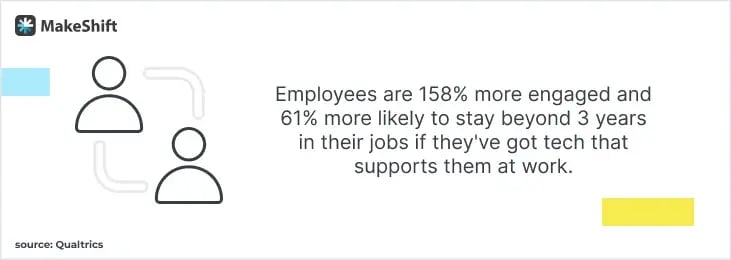
Want to empower staff to fill open shifts?
Adopt staff scheduling software to give them easy access to schedule management. Here’s how…
How to Empower Your Staff To Fill Open Shifts with Staff Scheduling Software
We know a thing or 2 about workplace culture. We’ve earned a Great Place to Work® certification after an extensive, independent analysis by the Great Place to Work Institute®.
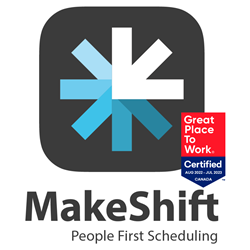
The award is based solely on what our employees say about their experience working at MakeShift via an extensive, anonymous survey.
We’re pretty proud of that.
We’re a people-first organization, and we know first-hand how happy employees take more ownership of their work roles.
MakeShift scheduling software gives your employees easy access to their schedules.
So they can set availability or address open shifts on their phones from wherever they are.
These 2 features are key to empowering your staff:
Fill available shifts — Filling available shifts is one of MakeShift’s core and most valuable features. It helps ensure there are no holes in your schedule and that the employees who are willing and able to pick up shifts know about them.
This feature empowers your staff to take control of their schedule by allowing them easy access to fill open shifts. Your team can:
- Broadcast available shifts to staff to fill schedule gaps.
- Send available shifts based on specific skills or certifications, ensuring that the most qualified staff are able to bid on the shift.
- Schedules are immediately updated when an available shift is assigned, and employees are notified if their request was declined.
-2.png?width=600&height=600&name=unnamed%20(3)-2.png)
Manage shifts from anywhere — The MakeShift app for iOS and Android gives your team an up-to-date look at their work schedule.
- Employees can view their schedules and receive notifications about schedule changes as they happen.
- Employees can subscribe to their preferred calendar app or share their calendar with friends or family.
- Employees can see who they're working with on any given day.
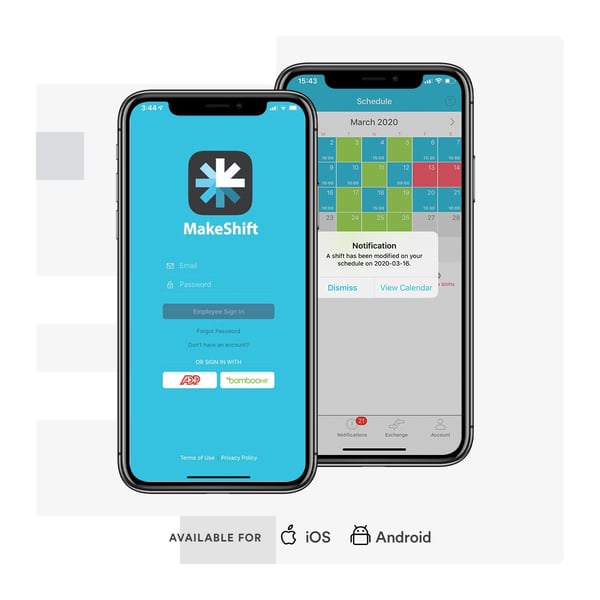
FAQ About Open Shifts
What Is an open shift?
An approved shift slot that hasn’t been assigned to an employee yet.
Why do open shifts happen?
Typically open shifts happen when an employee can’t fulfill their scheduled shift because of:
- Illness
- Personal emergencies
- Scheduling conflicts
- No show
What work challenges cause open shifts?
- Low Employee Satisfaction — Only 17.1% of in-office employees are satisfied with their work-life balance.
- Mental & Physical Health Issues — According to the Mental Health Foundation, 14.7% of employees struggle with work-related mental health problems. Women in full-time positions are 2X as likely to be plagued with mental health issues.
- Absenteeism — More call-outs. An international survey by SHRM indicates that productivity loss in the U.S. is 36.6% for unplanned absences.
- Chaotic Scheduling — 40% of deskless workers (mostly shift workers) say they’d rather have a flexible schedule than a pay raise, and 30% say they’ve left a job due to a lack of notice in scheduling changes.
- High Staff Turnover — 174% more turnover occurs due to errors from manual schedule creation.
How do I request an open shift in the MakeShift app?
If you’d like to view all available shifts in a list view, click on “Available Shifts” at the bottom of the Schedule. You’ll see a list of all available shifts sent out by your manager. Click on a shift that you’d like to request, then click “Request This Shift”.
How do you get employees to pick up open shifts?
Make it easy for them to access the current work schedule and make requests. Staff scheduling software lets your employees request an open shift or swap shifts on their phones.
Encourage Your Staff to Fill Open Shifts Through a Better Work Culture
The long and short of it is that motivated, engaged employees take more ownership of their work roles.
They don’t ditch work or leave open shifts for you to scramble to fill.
Happy employees care about whether their shift is covered, and they’ll take action to ensure that.
Want help in upping your employee experience with smarter scheduling? Sign up for a free demo to see how MakeShift can help.




